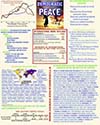[First published May 2, 2005] RETRACTION: In case you read it in yesterday’s Part I, before I edited it out: I lost my cool at the end of the blog and called for the democracies to make war on these bloody mortacracies (a thanks to Walter W. Cox for questioning it). I retract that as an irrational and dangerous thrashing about. I had just seen the previous night the A&E “Flight 93” and 9/11 recap, and then stupidly wrote my Part I about the bloody mortacracies. But the question as to what to do about these mortacracies has to be answered sensibly, and as a last part in this series, I will try to write a more nuanced, practical, and rational blog on what the democracies can do about these mortacracies.
Now, in Part I, I defined the gang of democide committing mortacracies. But what about those regimes whose actions create such life threatening conditions as to unintentionally cause the mass death of their people?
Consider Zimbabwe, for example. The Marxist policies of the Robert Mugabe gang that rules the country by force (the country is rated not free by Freedom House), have caused a country that had a relatively high standard of living for Africa before Mugabe’s rule to deteriorate into being among its poorest. It has an unemployment rate of over 70 percent, and the world’s highest inflation rate at 900% (a roll of toilet paper now costs $145,750 Zimbabwean dollars). There is a crisis food shortage that without outside aid will turn into a famine, and fuel is hard to get. Its economy has collapsed by about 40 percent, dragging down the country’s standard of living such that the people now have among the shortest lives in Africa. Their life expectancy (LE) at birth is 36.7 years, and continues to fall. Compare this to 82 years for Japan, the highest among sovereign countries, and 77.1 years for the United States. The chart below shows the six-year movement in Zimbabwe’s LE (If the chart does not show, click here)
Moreover, Mugabe suppresses speech, curtails and controls civil organizations, and corruption is widespread among officials. He has set his army on opposition supporters, using rape as a preferred weapon. And he continues to expropriate land owned by Whites. The 2005 Human Development Report gives Zimbabwe a human development index (HDI) of .50, while for comparison it is .94 for the U.S., .91 for Israel, and an average of .74 for the world.
What bothers me most about this is how young, by my standards, people are on the average when they die in Zimbabwe and other such thug regimes. Many of us were just getting started in life at that age these people die. And to die from the conditions you are forced to live under though no fault of your own, conditions created or allowed to continue by the gang that rules, such as massive corruption, hyper-inflation, extensive personal and mass violence, high unemployment, illiteracy, food shortages, malnutrition, and very poor medical services and facilities. While the resulting early deaths are not democide, since unintended by the regime, the regime still should be held responsible for them in my view.
The question is how to characterize these deadly conditions, if such ready terms such as genocide, politicide, and democide are inapplicable. First, I suggest that the term mortacracy, that I have applied to mass murdering regimes, be extended to regimes like Mugabe’s. That is, they commit mortality—they cause their people to die. Mortacracies mortalize their people.
Of course, one obvious way of defining such mortacracies is by the life expectancy (LE) of a country’s people at birth. Then, those countries near or at the bottom might comprise our best list of mortacracies.
To my knowledge, this is a new line of research, and there is no guidance but intuition in judging what is a low enough LE to reflect a true mortacracy at work. The 2003 life expectancies from birth (LE) for all countries, except notably for North Korea, are listed in the UN Human Development Report 2005. I plot them below (If the chart does not show, click here):
Each blue dot is a country’s LE, which tend to merge for all countries into a curving line. This is an incredibly uniform plot, as shown by the trend line—the best fitting third degree polynomial regression and its virtually perfect correlation R^2 of .99. The LEs begin to dip down at the low end, with two breaks, one a little below an LE of 60, and the other at an LE of 50. Breaks of this sort in an otherwise smooth plot indicate that there is something working on the very low LEs to cause the break and steeper decline in the trend line. This could be the greater mortality caused by mortacracies at this level, and reflected in their LEs. Below, I list all 28 countries that are below the break in LEs at 50 years, and include their freedom rating and scores (If the chart does not show, click here).
Among the 28, 5 are free, 13 are partly free, and 10 are not free. South Africa, which is rated free, is recovering from the years during which the Whites’ policy of apartheid segregated the near 80 percent Black population in the impoverished, undeveloped, and ill-nourished areas of the country, with few health services. Even though the present liberal democratic government is trying to develop and improve the conditions of the largely Black areas, the LE has only increased slowly due to the overwhelming task of improving in the short run the conditions of life and education for 35 million Blacks.
Near the bottom of LEs is Lesotho, which became free one year before. And it is still is recovering from a military coup, violence, assassinations, three years of poor harvests, corruption, and a sharp rise in HIV/AIDS cases. In other words, democracy has not had time to influence the death rate. As to Botswana, which is a stable and long running democracy, it has been ravaged by an AIDS/AIDS epidemic that infects about one-third of the population and which has caused economic problems, including 40 percent unemployment.
Namibia and Mali are also free countries below the cut-off LE of 50. Until its independence in 1990, Namibia was ruled by South Africa and its 87 percent Blacks also suffered under the apartheid system. In addition, under South African control Namibians violently intervened in the Angola civil war, besides being plagued with its own guerrilla war. Since independence, the democratic government has undertaken economic development, fair land reform, and a huge power development program. It now provides encouragement to extensive foreign investment. As for Mali, it is still recovering from 30 years of corrupt and rapacious military or corrupt one-party rule. This ended in 1992 with a fair and open democratic election, but it left the country terribly impoverished. Nonetheless, there has been steady improvement in the economy, much of which has yet to reach most of the people.
Then there are the remaining countries, such as the Central African Republic, Congo, Ethiopia, Sierra Leone, Uganda, and Zambia, which have been ruled by corrupt and violent tyrants, treating their countries as their own preserve, raping the resources for their own benefit and that of their relatives and tribesmen, killing and murdering to keep power, and showing virtually no interest in the well being of their people. Their abysmally low LEs reflect this.
But is the raw LE the best measure of mortacracies? LE is only one indicator of a regime’s effect on life. Perhaps I should consider, in addition to an index to LE, a wider measure of human underdevelopment that takes into account LE’s social and economic context. Such is the Human Development Index, which I will look at in Part III in order to refine my definition of the world’s mortacracies.
NOTE: The Brookings Institute recently held a forum on US policy options for
Darfur. It included presentations by the United States Deputy Secretary of State Robert Zoellick and the Representative of the UN Secretary-General on Displaced Persons Francis Deng, among others. A full pdf transcript is available here. Otherwise, C-Span has the entire event on video, which can be seen here (real player needed).
Link of Note
“4 million dead in Congo” December 22, 2004:
” THE WORLD’S biggest war may be its most invisible. In 10 years, an estimated 4 million have died in eastern Congo. A maelstrom of invading forces, local militia, a central army and United Nations peacekeepers shoot their way across the landscape…. In general, the Congo war is a scattershot conflict based on ethnicity and survival. The death rate, according to a relief group, the International Rescue Committee, runs at 1,000 people a day. These deaths, like the millions before, stem from hunger and disease, both preventable by peace.”
“Counting the dead” April 10, 2003:
“So now we know: up to 4.7 million people have died in the Democratic Republic of Congo’s four-and-a-half-year civil war. The figure was announced this week by the International Rescue Committee, an American aid agency. Its lower estimate was 3.1 million….”
“Mortality in the Democratic Republic of Congo: a nationwide survey” January 7, 2006 (free registration required):
” Commencing in 1998, the war in the Democratic Republic of Congo has been a humanitarian disaster, but has drawn little response from the international community. To document rates and trends in mortality and provide recommendations for political and humanitarian interventions, we did a nationwide mortality survey during April–July, 2004…. Total death toll from the conflict (1998–2004) was estimated to be 3·9 million. Mortality rate was higher in unstable eastern provinces, showing the effect of insecurity. Most deaths were from easily preventable and treatable illnesses rather than violence. Regression analysis suggested that if the effects of violence were removed, all-cause mortality could fall to almost normal rates.”
RJR: Can there be any doubt that the Congo (Kinshasa, or former Zaire), classified as not free by Freedom House, is a mortacracy?



 Posted by rudyrummel
Posted by rudyrummel 






